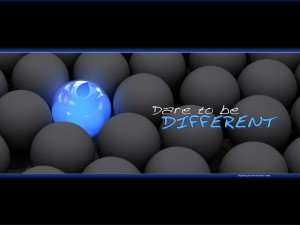Would your product really be missed?
“In category after category, companies have gotten so locked into a particular cadence of competition that they appear to have lost sight of their mandate – which is to create meaningful grooves of separation from one another. Consequently, the harder they compete, the less differentiated they become…Products are no longer competing against each other; they are collapsing into each other in the minds of anyone who consumes them.”
– Youngme Moon, author of Different
Several times in my life I have been a part of creating and launching successful and original products. And each time we’ve never paid much attention to what anyone else was doing.
The first successful launch was in 1993, when my father Hal had a crazy notion to take content experts into television studios and broadcast live their classroom presentations, and use phone and fax machines for interactivity. Insane. Who would do such a thing? Who would buy it? He very nearly conjured the idea out of thin air. He reasoned that instructors could reach more audiences using television technology, and people with satellite dishes would pay for learning at a distance. Reasonable extrapolation, but it wasn’t modeled against an existing business he knew of.
After over a year into the effort we were contacted by companies and groups who were creating (or had created) just such a learning service. As you might imagine, since we never “benchmarked” ourselves against what anyone else had done, we were busy making our own mistakes. With persistence, and many mistakes, it worked. We still create live, satellite-delivered (well, mostly webcast-delivered) presentations today.
The first colossal failure came when we did try to copy what another company was doing. We discovered after a few years that there were entire digital satellite networks dedicated to delivering learning content. National Technological University (still exists but the network folded), PBS, The Business Channel (ran out of funding), RTN Group (folded, and yes, that domain is for sale…), had all ventured into the business of building real-time digital satellite networks and failed. We figured we would win because we were smaller, faster, more nimble, could operate more cheaply. All of these things were true. The problem was that no matter how cheaply we could deliver the service, it didn’t matter because no one was buying.
The problem with head-to-head competition now is that since the technical ability to emulate and copy someone else is so easy, it’s hard to differentiate. In an earlier time, companies could develop a proprietary platform, technology, or capability, and lead with that advantage for some time, possibly years, before anyone could catch up. Now, technology is the great equalizer. Whatever you can dream up, someone else can copy. And if you follow this treadmill, it leads inevitably to feature explosion and product augmentation. The trick is to do something your competition isn’t willing to do. The trick is to take that chance that no one else is willing to take, precisely because it hasn’t been tried. Only if you are willing to wildly fail, can you wildly succeed.
Harvard professor Youngme Moon, in her book Different, describes those products and companies that learn to thrive in this world of easy equivalence, as those companies who are willing to swim against the tide of incremental improvement and feature addition. She describes these successful products as “lopsided.” That is, they accentuate what the rest of the pack is unwilling to emphasize due to perceived risk. The result of the copy-cat economy is that while product developers may be able to tell you the nuances that distinguish their products from everyone else’s, the truth is no one cares.
In the words of Jim Collins, the real question you want to answer is: If your company went out of business tomorrow, would anybody really miss it?




